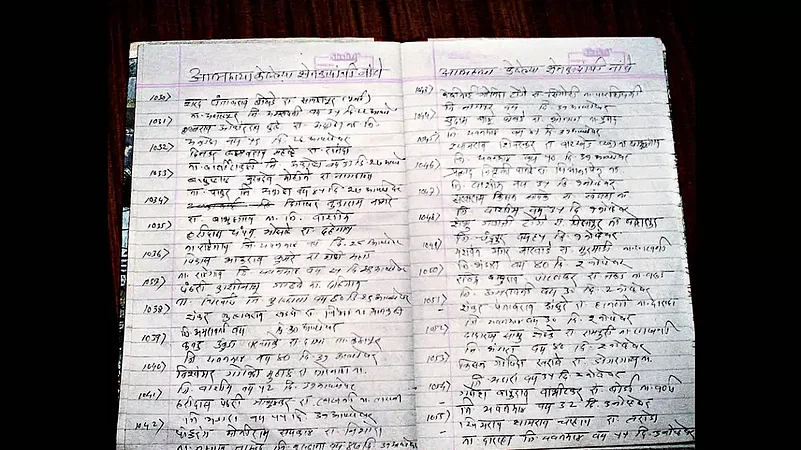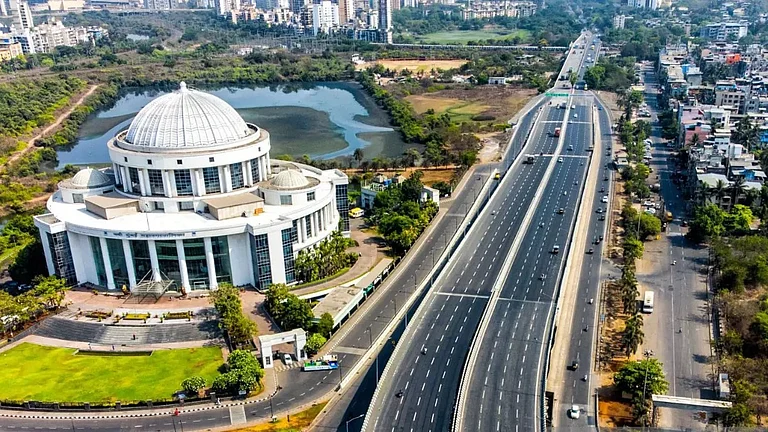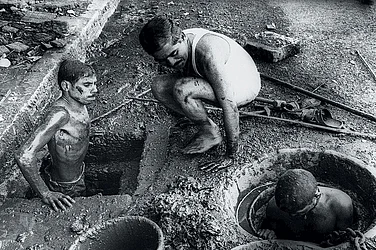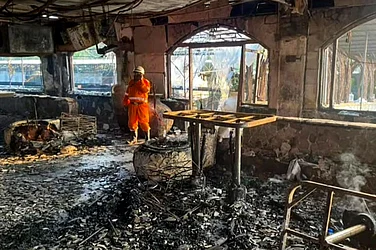On August 31 this year, 11 farmers jumped into the safety net at Mantralaya, the administrative headquarters of the Maharashtra government in Mumbai, in a bid to kill themselves. They had all entered the Secretariat separately with the authorised passes handed out to them at the Mantralaya gates. The 11—against whom the police have registered cases of attempt to suicide—say they did it out of desperation.
Most residents of Morshi village in Amravati district of the state say they attempted suicide as they were refused compensation for their land acquired by the state government for the Upper Wardha Dam project.
For over two decades, Maharashtra has hit the headlines for farmers’ suicides. On June 30, a report—which was submitted to the state government—outlined several distressing facts, including that one lakh farmer families in the Marathwada region have been categorised as “highly sensitive suicide prone”.
Like every other household, weddings are a lavish affair in the houses of farmers. They borrow heavily from private moneylenders or sawkars using their land as collateral. These moneylenders charge high rates of interest, with borrowers paying through their lives. If the farmer dies, then the burden of repayment is transferred to the family of the farmer. “The farmers do not understand the transaction with the sawkar. Whatever the sawkar says is the last word. Families, and often generations, end up paying the debt, when in reality, it has been paid several years ago,” says Ramchandra Namdar, who has been helping farmers understand the perils of dealing with sawkars.

The farmers have to also give a part of the crop yield to the sawkars, which is in addition to the repayment. This produce is collected by the moneylender and sold back to the farmer when he is in dire straits and runs out of foodgrains at home.
According to a source, the farmers in Vidarbha and Marathwada are heavily dependent on BT seeds for higher yields. These are available at government-certified Krishi Kendras, which are located at centres in the tehsil. According to sources, there is rampant corruption at these centres. Since farmers buy seeds on credit, they are charged an interest of 15-20 per cent on the purchase. This extra amount that is paid as interest is pocketed by the middlemen who operate on behalf of the Kendras. There is no record of this transaction, says a government source.
The mounting debt levels have a social fallout. With families taking advantage of the government-sponsored free education for girls, the literacy level of girls in the villages and districts is higher than that of the boys. Siddesh Kulkarni, a farmer from Nanded, has been rejected by 15 girls who refused to marry him because he is a farmer. So, he hired a kirana shop in the marketplace and started operating the business of his uncle. By the third month, he got married to a girl who was more educated than him. After his marriage, he returned the shop to his uncle and went back to being a farmer. His wife of three months has now gone back to her maternal home as she does not want “to live in poverty” all her life, says Kulkarni.
Sources say that boys are dropping out of schools due to financial constraints. However, angered by poverty, they are not interested in working in their fields. They migrate to the cities and work as loaders, labourers, construction workers and security guards.
The Rajiv Gandhi Health Scheme, under which major ailments are treated, has seen a sharp increase in diabetes, cancer and heart disease cases among the farmers and their families, says a government source. Paediatric ailments and depression cases too have increased in Marathwada and Vidarbha. “Farmers consume large quantities of tobacco and khira—a beaten mixture of strong tobacco, kaath and slaked lime that is more potent than gutkha. It is now banned in Maharashtra. This helps them work longer hours in the fields. But it has led to various health problems. Coupled with debt, it becomes a major reason for suicides,” says the government source. Both Vidarbha and Marathwada have bigger issues—the decreasing acreage under cultivation. While Vidarbha has excessive rains causing widespread floods and damage to standing crops, Marathwada, with its severe drought every year, sees a different kind of crop damage. Both these regions witness large-scale migration of farmers to the cities.
Alcoholism is another fallout of the severe physical and financial stress. “It is difficult to counsel them as we often come to know of their mental situation when it is in the severe stage. There is also social stigma attached to counselling about mental health,” says Preeti Banerjee, a mental health counsellor.
According to reports of the Maharashtra Government, 26,566 farmers died by suicide between 2013 and 2022. On an average, there have been 2,657 suicides a year and an average of seven farmer suicides every day in the last 19 years. A survey conducted by the state government also revealed that 80 per cent of those who died by suicide fall in the 18-60 years category. They are mainly small- and medium-scale landholders. Of these, 93 per cent were married.
The Karnataka Suicide Saga
It was a rather humid day in the middle of September 2018 in Karnataka’s sugarcane belt, Mandya. Nandish, 37, a farmer who cultivated sugarcane, his wife, Komala, 30, and their children, Chandana, 12, and Manoj, 8, were supposed to eat dinner together. He had availed loans of up to Rs 20 lakh from a private moneylender, cooperative banks, SHGs and other sources. But all his crops failed to yield him any money to repay the loans. He bought chicken kebab for dinner, and laced it with poison.
“I am not dying as a coward, but I could not clear my liabilities in spite of my best efforts,” he said in a note left behind for the then Chief Minister H D Kumaraswamy. Nandish was among the 2,405 farmers who died by suicide in the state in 2018, the second-highest in India, after Maharashtra.
While there is no single explanation for these suicides, rising personal debt is a looming threat for many in the region. A report by Karnataka Janashakti—a group of local researchers, farmers and activists—revealed that the average debt of the farmers who died by suicide until 2015 was Rs 5 lakh, a significant amount when compared to the average debt of about Rs 18,000 per capita for the general population of Karnataka. If today the cost of cultivation is Rs 5,400, the government provides support of around Rs 2,500, which is less than half, says K Boraiah, the general secretary of a prominent farmer group, Raita Sangha, in Karnataka. “This is a complete loss for us. Farmers lose the land and since they are already economically backward, they think there is only one route left to take—that of suicide,” he says.
Mandya—The Sugarbowl
The newly constructed Bengaluru-Mysuru expressway, with pristine fields of sugarcane on either side, passes through the district of Mandya, also known as the Sugar City. The constituency has six sugar mills, including one run by the government and two cooperative mills. While more than 25 lakh farmers grow sugarcane, they allege that these factories have not cleared dues for over a year.
It was 60-year-old Ninge Gowda’s suicide in 2015 that first rattled the state government. In that year, according to government records, Karnataka’s sugar manufacturing factories owed farmers around Rs 1,000 crore for produce sold over a period of two years. After suffering heavy losses due to the falling sugarcane prices and inability to repay loans, the sugarcane farmer from Pandavapura taluk in Mandya district set his standing sugarcane crop on fire and jumped into it. Further, the closure of the only government-run sugar factory, Mysugar, added to the delay in the payment of wages for those who had harvested sugarcane.
As of June 30 this year, Karnataka had an outstanding combined debt of Rs 1.81 lakh crore, according to data tabled by the Union Finance Ministry in the Lok Sabha. “Most of the farmers who kill themselves live in the highly irrigated areas as compared to farmers who reside in drought-affected areas, as the loans they take for those areas are higher. The government has not paid our dues on time for consecutive years now,” says Sunanda Jayaram, a farmer from Maddur taluk in Mandya.
While most farmer households are indebted to private moneylenders, several farmers from the region have levelled allegations against cooperative banks and scheduled commercial banks. They say that they lack a humane policy to clear outstanding dues. It has also been noted that most farmers who died by suicide in 2015-16 had borrowed from State Cooperative Banks and Regional Rural Banks, more than private or local moneylenders.
Meanwhile, those who have been left behind are widowed farmers, who struggle to work in the fields due to physical ailments.
Suicide by Women Farmers
“We correctly focus on the invisibility of women in the statistical systems; all that is true, but apart from invisibility there is something hiding in plain sight which is what happens with women farmers and women farmers’ suicides,” says senior journalist P Sainath. Researchers say that many girls and women have been pushed into the column of ‘housewives’ in the National Crime Records Bureau (NCRB) data on suicides/accidental deaths. “When someone says farmer, people only think of male farmers, and not females. Even in the case of suicides of male farmers, while the loan burden is transferred to the woman, the land title is never awarded to the woman,” says Kavitha Kuruganti of the Mahila Kisan Adhikaar Manch (MAKAAM).
Chowdamma is a 62-year-old cultivator from Thippasandra village, Kolar district, whose husband, Munivenkatappa, died by suicide after consuming pesticides in February 2019. Chowdamma is now alone and has an immense financial burden on her shoulders. She has not received any compensation from the government because the deceased did not have any institutional loan, her children say.
Just like Chowdamma, thousands of farmer families face the double burden of repaying loans along with coping with the death of their loved ones. MAKAAM, an organisation that helps share stories of such women and supports them to cope with farmer suicides, has been demanding that the Karnataka Government prioritise the rehabilitation of women farmers who have been affected by farmer suicides and allocate funds for the same in the state budget.
To prevent suicides in the first place, NGOs and organisations like MAKAAM have demanded that state governments undertake vulnerability mapping of those areas where suicides have already been reported in greater numbers; where there are repeated crop failures; and, where levels of indebtedness are high. The organisations say that in such “suicide-prone” areas, all the departments concerned must reach out to the farmers directly to ensure that schemes are being accessed by the needy; to provide them counselling; and to set up help counters and helplines for the farmers and their families.
Haima Deshpande in Mumbai & Anisha Reddy in Bengaluru
(This appeared in the print as 'Seeds Of Distress')


























